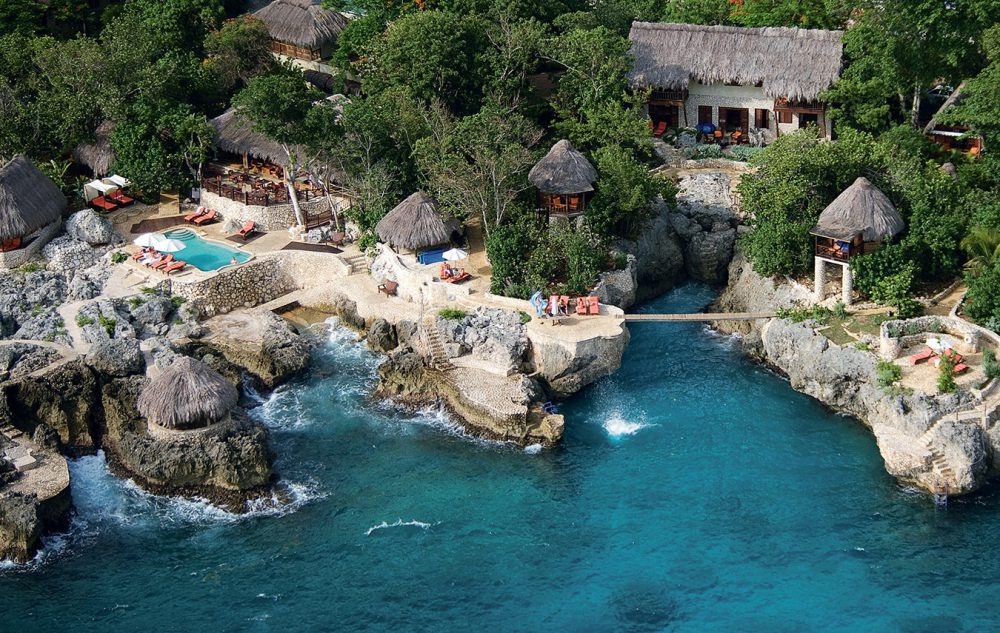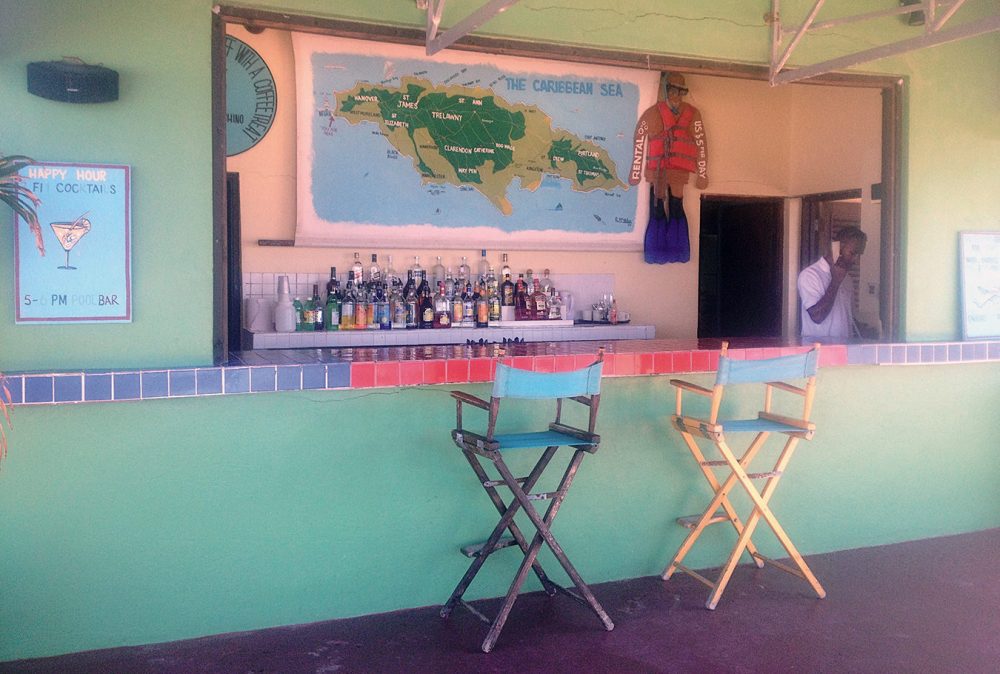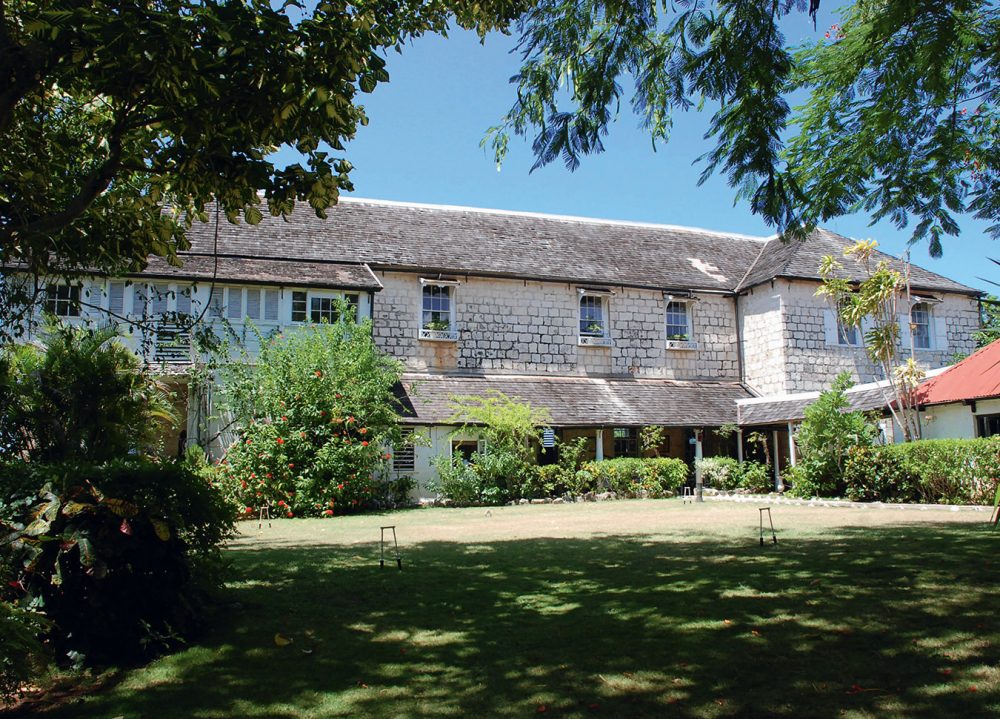Jamaica is a country of vivid colours—endless blue skies, transparent turquoise waters, dazzling white sand, lush green foliage, and the colours of the flag (yellow, black, and green) painted proudly on everything from doors and walls to roadside fences. It’s a small island with a big voice.
Leviathan resorts on the island, are ever popular, with people spilling out onto beaches to lounge under umbrellas in neat rows of reclining chairs. The all-inclusives are crowd-pleasers for good reason: you can leave your cares at home and your wallet safe in the hotel room. (And liquor flows easily from the bar when you’ve already paid.) The more indulgent and uninhibited revellers stay at Hedonism II, a resort that unabashedly boasts, “Everything you’ve heard is true.” (That includes toga parties, midnight nude volleyball games, and the king-size mirrors mounted directly above the beds.) But so as not to exclude, Hedonism II is divided into two parts—“nude” and “prude”—so there’s something for everyone.
There are, however, a number of small villas on the western tip of the island in Negril, away from all the clamour and excitement and far from the reaches of aggressive beach vendors hawking handmade baubles. Negril was once a tiny fishing village, but tourism in developed in the 1960s when local residents would invite travellers—backpackers and hippies—into their homes. Today, the town remains fairly undeveloped, which adds to its charm.
Tensing Pen is a sleepy resort tucked away in Negril’s West End. Privacy is absolute in this small cluster of cottages, 19 in total. The thatched roofs prevent heat from getting in, keeping dwellings cool. The roofs also swell when wet, keeping the interior dry—the technology goes back hundreds of years, and was used by Jamaica’s first inhabitants, the Taínos. There’s also a deliberate absence of television sets and telephones in each cottage.
Outside the cottages, a favourite little spot on the resort is a narrow 30-foot-long footbridge over a translucent lagoon—and if you can make the leap, you may find yourself wanting to do it again. Grab a snorkel and flippers and follow the paved path through prickly coral to explore an underwater world just over the cliff and under the sea. Or simply lie in hammocks by the water. To the delight of guests, three curious Rhodesian Ridgebacks roam the property. Tensing Pen is intimate and peaceful—the ideal place to put your mind and body at ease.
And if the sounds of the seaside aren’t soothing enough, the spa at Rockhouse Hotel is only two minutes’ drive from Tensing Pen. All the products are made locally using only natural ingredients indigenous to the Caribbean. The spa menu is extensive; fans of Blue Mountain coffee will enjoy the java-based scrub blended with orange, cinnamon, nutmeg, vanilla, and brown sugar, while liquor lovers might appreciate the rum wrap, with honey, mango, hemp, cocoa, and shea butter.
Montego Bay in neighbouring Saint James parish is Jamaica’s second-largest city by area. In early maps, it was labelled Bahia de Manteca, or “Lard Bay”, because the Spanish hunted wild hogs and exported lard from the port there. Montego Bay has come a long way from its humble roots. Today, the city’s infrastructure is going through a massive overhaul in an effort to keep Mo’Bay a top destination in the Caribbean. It’s also home to five championship golf courses.
Golden Castle Golf and Spa is a 21,000-square-foot castle in the sky atop Cinnamon Hill Golf Course. A pair of tall double doors swing open into a two-storey entrance hall. The 12 guest rooms are named after Jamaica’s parishes, with decor that reflects the character of each. It’s quite the luxurious hideaway, with suites fit for royalty; as they say, “your fantasy escape is in full regalia.” Golden Castle has all the requisite amenities, including a Jacuzzi, spa, sauna, movie theatre, and fitness centre.
For a window into Jamaica’s past, the Greenwood Great House, 24 kilometres east of Montego Bay, is a must-see. The estate originally belonged to Elizabeth Barrett Browning’s family. In 1655, the British expedition to capture Hispaniola from Spain failed, so they seized Jamaica instead. Hersey Barrett, an officer of the party, was granted lands and settled there. Like others of its kind, the Georgian-style great house was built in the 1780s as the centrepiece for a large sugar plantation. The Barretts’ wealth grew immensely, and they eventually owned over 84,000 acres and 2,000 slaves. Unlike their contemporaries, the family treated their slaves relatively well and provided them with education; the Greenwood Great House survived the Christmas Rebellion of 1831, when 60,000 of Jamaica’s slave population of 300,000 revolted and set fire to a great number of plantation buildings.
Today, Greenwood Great House is home to the largest antique collection in the Caribbean, and is recognized by the government of Jamaica as a National Heritage Site. Inside, much of the original furniture remains intact. Among the pieces are intriguing objects including an old fire pump, a court jester’s chair, and original Wedgwood china. Other artifacts point to the more gruesome aspects of the time, such as a mantrap used to violently ensnare runaway slaves. There are also musical relics, which can be roused from their slumber. Lovely minuets, played from one of the two Polyphons, sound rather haunting. A warbling off-key tune can still be coaxed out of the barrel organ, which dates from 1874. The discordant notes tumble out: “Daisy, Daisy, give me your answer, do.”
Outside, a 22-metre-long upper veranda, facing north, provides a commanding view of the Caribbean Sea. The horizon runs unobstructed for 180 degrees, making visible the curvature of the Earth. In the distance, the turquoise waters suddenly give way to a dark blue mass indicating the Cayman Trough, a 7.7-kilometre drop.
Last year, Jamaica celebrated the 50th anniversary of its independence with a myriad of cultural and sporting events and musical and dance performances. In commemoration, Appleton Estate released a limited edition 50-year-old rum called the Jamaica Independence Reserve, now the oldest in the world. This iteration of Jamaica’s “finest legal export”—as it’s described in a series of witty ad campaigns—comprises rums that have been aged for a minimum of half a century in oak barrels.
Rum, coffee, blue water, jerk chicken, dancing, and all that rich history make Jamaica a fascinating experience. Just remember to bring sunscreen, and be ready to be inundated: with living colour.











